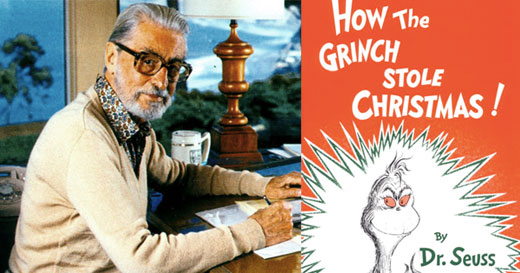He had a Grinch license plate, they were the same age and so much more.
Nothing says “June 15th” like writing about a Christmas book.
1957 may have been Dr. Seuss’s peak year, as it brought the publication of two of his most iconic books: The Cat in the Hat in March and How the Grinch Stole Christmas in November. Over the years, there was a theory that the Cat was really Seuss — mischievous, free spirited, only truly comprehendible by the pure minds of children.
But I tend to lean toward another theory: That Seuss’s 1957 autobiography wasn’t The Cat in the Hat, it was How the Grinch Stole Christmas.

Here are 11 pieces of evidence that the Grinch was Theodore Geisel.
1 | He was against the commercialization of Christmas dating back (at least) to when he was in college
When Ted Geisel was at Dartmouth in 1924, working for the newspaper, he wrote an article called Santa Claus Be Hanged, decrying the focus on presents at Christmas. That’s sort of a Grinch origin story moment for him.
2 | The Grinch was 53, just like Seuss when the book came out
The Grinch says: “For 53 years I’ve put up with it now! I MUST stop this Christmas from coming but HOW?” Seuss virtually never gives his characters ages, so it’s notable that the Grinch got one — and such an autobiographical one.
3 | He had a “GRINCH” license plate
Clearly he wasn’t afraid to broadcast his affiliation with the Grinch, and chose that for his license plate over his many, many, many non-villain characters. LORAX? HORTON? SAM I AM? YERTLE? To that point…
4 | The Grinch was his first adult main character, and first villain main character
The Grinch got very rarified treatment, as both the first adult and first bad guy to take the main focus of a book. (Unless you count The Cat in the Hat as an adult, a villain, or both — and arguments can be made for the accuracy of those claims, especially if you see the Mike Myers Cat in the Hat. Perhaps the Grinch is the first who’s outwardly villainous.)
5 | Seuss was quirky, antisocial and avoided crowds
His social relationships mirror those of the Grinch, with La Jolla, California, as a stand-in for Whoville, I guess, and the people of La Jolla as the Whos. I’m not sure they’d find that gnarly OR radical, but it was decades ago so I’d assume they’re over it. And Seuss’s Grinch-esque isolation extends even further, too.
6 | He observed people below from a tower
Much like the Grinch would observe the Whos from his cave, Seuss would observe the people when he worked in his tower.
7 | The Grinch was drawn as a self portrait
The Grinch wasn’t always green; he started as a pale white with red eyes and only became green when the animated movie came to be. It’s not just speculation that the Grinch was at least somewhat based on Seuss drawing a self-portrait. When Seuss was asked how he came up with the look of the Grinch, he said, “It was simple. I just drew him and looked at him, and it was obvious to me who he was.”
8 | He wrote the book quickly but struggled for months with the ending
It seems like he wasn’t just struggling with the ending to a story — he was struggling to work through all of his own issues surrounding Christmas to figure out what the ultimate takeaway really should be. They always say the hardest thing to write in your autobiography is the last page. Actually, I’m not sure anyone’s ever said that, but it seems like something the proverbial “they” might say, right?
9 | The original literary appearance of the Grinch lined up even more with his life
Before he became Dr. Seuss, Geisel’s job was drawing cartoons for advertisements. He hated it. So he wrote a poem called The Hoobub and the Grinch in 1955 (two years before the book) for Redbook magazine. In that poem, the Grinch is a salesman who cons people called Hoobubs into believing a worthless piece of green string is valuable. And the poem concludes with his personal commentary on how advertisers — like the ones he worked for and like the one he worked as — will say and do anything to con people into buying crap: “And I’m sorry to say that Grinches sell Hoobubs such things every day.”
10 | His stepdaughter more or less admitted it
In a speech in 2003, Seuss’s stepdaughter, Lark Diamond-Cates, said, “I always thought the Cat was Ted on his good days, and the Grinch was Ted on his bad days.” That’s pretty good second-hand evidence. How about some first-hand?
11 | Seuss more or less admitted he was the Grinch
In an interview with Redbook magazine, he said, in not so many words, that the Grinch was him. (Side note: What’s with him and Redbook? Did he have a secret passion for low-fat muffin recipes or tips to stay fun and flirty after 50?) Seuss told them he was inspired to write the book when, the day after Christmas the previous year, he saw a “very Grinch-ish countenance in the mirror [and realized that] something had gone wrong with Christmas, or more likely with me. So I wrote the story to see if I could rediscover something about Christmas that I obviously lost.”